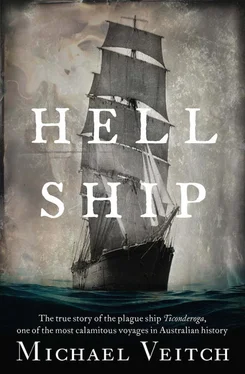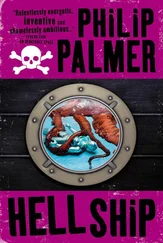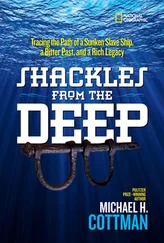Then, night by night, as the Ticonderoga edged slowly south, the passengers could come out onto the upper deck and find a quiet spot to observe the heavens, watching those northern constellations with which they had been familiar for their entire lives gradually dip ever lower on the horizon, before finally disappearing forever.
Due to the low rates of literacy on board the Ticonderoga , as well as the lack of light in the accommodation decks—not to mention the disaster which overtook her on the second half of the voyage—no passenger diaries from the trip have survived, if indeed they were ever written in the first place. More strangely, nor have any detailed first-hand accounts compiled in the aftermath come to light. There are, however, a number of fragments—usually written long afterwards—that paint a picture of the Ticonderoga ’s journey south.
Several of these make mention of one macabre incident early in the voyage, as word went around the ship one evening that a female passenger had thrown herself overboard. No further details could be gleaned, but a pall of horror was felt by all those on board. It was not until 1932 in an article in Melbourne’s The Argus newspaper that some explanation of the incident was offered by one of the survivors of the voyage, Mrs Ellen Bentley. The woman in question had apparently recently eloped with her father’s footman, a decision she soon regretted. ‘Repentance came early,’ recounted Mrs Bentley. Observed to be in ‘deep distress’ early in the voyage, the woman became more and more consumed with remorse until ‘a leap overboard ended her suffering’.
Just eight days out of Liverpool, the first infant died—not of disease, but marasmus, a wasting condition brought on by lack of nutrients, especially protein. Little Samuel Ritchie was the youngest child of James and Mary Ritchie of Inverness. The news was not greeted as anything out of the ordinary: infants died routinely in the mid-nineteenth century of marasmus and many other ailments, and death rates at sea among the very young were particularly high. It was a requirement at sea that adults be buried during daylight hours to provide the proper decorum of prayers and service, but children could be given to the deep quickly, quietly and at night. The farewelling of the Ticonderoga ’s first victim was nevertheless a solemn occasion, presided over by Captain Boyle reading the appropriate passages from the Bible and ship’s order of service, standing beside the grieving Ritchie family as the pathetic white package wrapped in a patch of sailcloth was sent to the deep, weighed down with a small ship’s iron from the carpenter’s shop. For the Ritchies, as for many other families, the funeral of little Samuel would be only the first.
The high toll of babies and infants on board the Ticonderoga is not difficult to account for. The effect of the harsh and unfamiliar ship’s diet on already weakened and under-nourished people began to take its toll, particularly in combination with the added debilitating effects of seasickness. Women, then as now, have a greater predisposition to motion sickness in general, [1] Haines, 2005, p. 9
and on board the Ticonderoga, breastfeeding mothers were most vulnerable. For days or even weeks, they could be laid up, exhausted and incapacitated, barely able to look after themselves, let alone their suckling infants. With no special provisions for infants, feeding them the ship’s diet could often make them sicker, so it was unsurprising that more babies and infants on board would waste away.
Just two days later, another child, Eliza Gardiner, four, likewise died of malnutrition, which again was regarded as standard. Then a bout of diarrhoea began to take hold, first in the single men’s quarters but spreading throughout the ship. Many people simply could not adjust to the diet, and suffered accordingly. Christopher McRae caught it early and, in his words, ‘suffered most of the time’. [2] Letter from Christopher McRae to Mr Kendall, 1917
Then, around 20 August, Anna Maria Hando, sixteen years old and travelling with her parents, though residing in the single girls’ quarters due to her age, came down with a high temperature and severe rash that covered her entire body. The Handos were one of several English families travelling from Somerset, a rural part of England that produced exactly the sort of skilled agricultural worker so sorely needed in Australia. William Hando, 44, was listed as a Church of England farm labourer from the village of Hutton near the seaside town of Weston-Super-Mare. Somewhat older than many of the passengers making the voyage, his skills were such that he and his family were accepted nonetheless, and both he and his wife Maria, 44, saw this as a God-given opportunity to begin a new life in the far-away, and quite unimaginable, colony of Victoria. Their family of seven was large, but by no means exceptionally so for the times. Their eldest son, Charles, also travelled apart from the rest of his family in the single male quarters in the bow, while William and Maria looked after Henry, ten, George, seven, and the youngest, Emma, aged four. The terrible condition being suffered by Anna Maria was recorded by Dr Sanger non-specifically as ‘fever’. This was not unusual. As Major J.H. Welch points out in his history of the quarantine station where the Ticonderoga would spend the final chapter of her journey to Victoria , ‘ in 1852, there was no knowledge of the cause of any disease which was characterised by fever’. [3] Welch 1969, p. 19
Indeed, the symbiotic nature of fevers and rashes had been long observed, but their relationship was barely understood. They were seen to act upon the body simultaneously, as were the radical physical changes they implemented in what was often an alarmingly short time.
Such conditions were known by many names: ship fever, prison fever, camp fever, spotted fever, Brill’s disease and others. Although the cause was a mystery, they were nevertheless observed to be in a terrible partnership with high fever, which itself changed and morphed in nature. It is likely that several different illnesses impacted the passengers on board the ship in the early stages—all of which Dr Sanger listed as fever, and the precise nature of which it is now impossible to determine. Later in the voyage, as a new and terrible strain took hold of more and more passengers, an equally terrible word would be settled on to describe it.
Over a few heart-wrenching days, young Anna Maria’s condition deteriorated, her rash deepened, her joints and internal organs ached in agony and, as her fever raged, delirium set in. Drs Sanger and Veitch looked on, did what they could to cool and calm the girl, supplied her with comforting sips of wine, arrowroot and other accepted tonics and remedies of the day, but could do nothing to save her. After three days, she lay still. The funeral of Anna Maria Hando, the Ticonderoga ’s third and oldest victim so far, signalled a terrible turning point on board the ship. In Fever Beach Mary Kruithof describes the poignant scene as the members of the Hando family, heartbroken and in shock, watch their beloved girl, taken on the cusp of life, descending to the deep:
Passengers from the married quarters, single women and some crew gathered on the upper deck for the funeral. Anna Maria’s shrouded and weighted body was placed on a wooden board which was carried to the upper deck and placed with one end slightly tipped over the side of the ship. With the ship’s bell tolling during the service, the Captain and Mr McKay read the burial service together. On the words, ‘We therefore commit her body to the sea’, the board was tilted, tipping the body into the water. The ship sailed on. A terrible loneliness swept over the mourners and a sad company filed back down into their quarters below. [4] Kruithof, 2002, p. 46
Читать дальше












